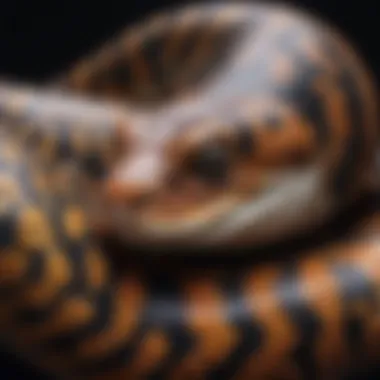Exploring the Unique Physical Traits of Pythons


Nature Topic Overview
Pythons are fascinating creatures found in various environments across the globe. These magnificent snakes come in numerous species, each exhibiting unique physical traits. Understanding their physical characteristics helps us appreciate their role in the ecosystem and how they adapt to different habitats. Throughout this article, we will explore the diverse color patterns, sizes, and anatomical features of pythons, revealing the remarkable qualities that define these reptiles.
Key Features to Discuss:
- Color Patterns: Different species of pythons display a wide array of colors and patterns that serve specific purposes.
- Sizes: Pythons vary greatly in size, from the smaller species to the giant ones like the reticulated python.
- Anatomy: Pythons possess unique anatomical traits that aid in their survival, such as specialized teeth and a flexible jaw.
Each of these aspects contributes to the python's ability to thrive in various environments, making them truly exceptional reptiles.
Fun Facts and Trivia
Did you know that pythons can eat prey much larger than their own heads? This is possible due to their highly flexible jaws.
Here are some interesting facts about pythons:
- Pythons can lay up to 100 eggs at a time.
- Some species can grow to be over 20 feet long.
- They are non-venomous, which means they kill their prey by constriction.
Including visuals such as images and videos of pythons can significantly enhance understanding and engagement, making learning about these creatures even more enjoyable.
Wildlife Explorations
There are several species of pythons, each adapted to their specific habitats:
Common Species:
- Burmese Python: Known for its size and distinctive yellow and brown patterns.
- Reticulated Python: One of the longest snakes in the world, often recognized by its complex pattern.
- Ball Python: A popular pet, they are smaller and have a beautiful spotted pattern.
In their natural habitats, these snakes share environments with many other animals. It can be interesting to learn about their interactions with local wildlife and the ecosystem as a whole.
Quizzes and puzzles can challenge young minds to think critically about these interactions and the role of pythons in their habitat.
Environmental Awareness
As with many species, pythons face threats from habitat loss and poaching. Conservation is essential for maintaining their populations and natural habitats. Educating children about these issues is increasingly important. Here are some tips that children can follow to help protect nature:
- Learn about local wildlife and respect their habitats.
- Participate in local clean-up events to keep habitats safe.
- Spread awareness by sharing what you learn about snakes and their importance in ecosystems.
DIY Nature Activities
Getting kids involved with nature can deepen their understanding of the environment. Here are some fun activities:
- Create a Python Habitat: Use materials from your backyard or room to build a model python habitat.
- Draw Your Own Python: Use colored pencils to create your own imaginative python, choosing your own colors and patterns.
- Go on a Nature Walk: Observe local wildlife and look for any snakes or habitats similar to those pythons live in.
These activities provide hands-on experience, making the learning process engaging and memorable.
Prelude to Pythons
Understanding pythons is essential for appreciating their role in our ecosystems and the complexity of reptilian life. This section sets the stage for a deeper inquiry into the various characteristics that define these fascinating creatures. Pythons are not only notable for their size but also for their diverse physical traits, which enable them to thrive in various environments.
Many people are intrigued by pythons due to their unique behaviors and adaptations. By exploring their physical characteristics, we can gain insights into how these attributes help them survive. This article aims to highlight specific aspects, such as coloration, size, and anatomical features, that contribute to pythons' success as a species.
Overview of Python Species
Pythons include several species, each exhibiting distinct traits and behaviors. Some are small and secretive, while others are large and more visible. Common species include the Burmese python, the reticulated python, and the ball python. These species vary in size, color, and habitat preferences. For example, the reticulated python is known for its impressive length and intricate patterns, while the ball python is recognized for its docile nature and modest size.
These differences are fascinating because they show how pythons have independently evolved to adapt to their specific environments. The great range within this family of snakes allows for a rich study of evolution and ecology.
Geographical Distribution
Pythons are distributed across a wide range of environments, primarily in Asia, Africa, and Australia. Their habitats include rainforests, grasslands, and even semi-desert areas.
- Indo-Australian Region: This region is home to several python species, including the carpet python and the olive python. They often reside in trees and bushes, utilizing camouflage to blend into their surroundings.
- African Regions: The African rock python is prevalent here. These pythons thrive near water bodies, where they can hunt their prey effectively. They take advantage of their environment to ambush unsuspecting animals.
- Southeast Asia: The Burmese python is well-known in this area. They inhabit swamps and marshlands, where they can easily hunt for amphibians and small mammals.


Understanding the geographical distribution of pythons reveals how they adapt to various environments. It also highlights the importance of different ecosystems in supporting diverse species.
"The adaptability of pythons to various habitats illustrates the remarkable paths of evolution within the reptile family."
This knowledge about pythons enhances our appreciation for their role in biodiversity and conservation efforts. The information outlined in this section is critical for scientists and enthusiasts alike, contributing to a broader understanding of these remarkable reptiles.
General Appearance of Pythons
The general appearance of pythons combines various physical features that are crucial for their survival. This section will focus on size and body structure. These factors illuminate how pythons adapt to their environments. Understanding this is essential for appreciating these remarkable reptiles.
Size and Length Variability
Average Sizes by Species
The average sizes of pythons differ significantly between species. For instance, the reticulated python is among the longest. An average reticulated python can reach around 20 feet, while the ball python averages between 3 to 5 feet.
This variability is important. It shows how different species evolved to fit their habitats.
Many people find large snakes fascinating, which makes why this knowledge beneficial. Some species are better suited for specific environments. The record lengths of certain species highlight extreme adaptability in larger habitats.
Record Lengths
When discussing record lengths, attention falls on the reticulated python, which holds the record for the longest snake ever documented. It was measured at over 25 feet. This characteristic captures interest and admiration.
Such lengths complicate handling and care, which is important for enthusiasts and zoo management. This aspect also leads to conversations regarding conservation efforts for these large reptiles.
Body Shape and Structure
Muscular Builds
Pythons possess a muscular build, which is crucial for their hunting methods. This anatomy allows them to capture and subdue prey. The strength of their body supports their constriction method during feeding. Therefore, understanding their muscular structure is beneficial.
These builds contribute greatly to fitness in various environments. The typical powerful physique enables efficient movement through diverse terrains. Still, larger pythons may require more food, presenting challenges in captivity.
Adaptations for Constriction
Adaptations for constriction vary by species, and this is vital for their predatory success. Pythons have developed robust bodies that can wrap tightly around prey. This constriction method is highly effective, enabling them to hunt a range of animals.
The unique structure of their muscles allows for an impressive grip.
Despite these advantages, such adaptations come with ecological implications. In a captive environment, these adaptations must be carefully considered, especially for ensuring proper needs are met.
Coloration and Patterns
Base Colors of Pythons
Common Colors
Common colors found in pythons include shades of brown, green, yellow, and gray. These colors help the snakes blend into their habitats, providing a layer of protection from predators. Brown and green hues are particularly effective in forested areas, helping the pythons stay hidden among leaves and branches. The key characteristic of these common colors is their ability to enable camouflage. This camouflage is beneficial not only for avoiding predators but also for ambushing prey.
Another unique feature of these colors is their ability to reflect and absorb light differently, which can help pythons regulate their body temperature. However, while common colors provide advantages in the wild, they can also limit a python's visibility to potential mates.
Species-Specific Variations
Species-specific variations showcase the diversity within the python family. Some species, like the Ball Python, have unique coloration patterns that include vibrant yellows and distinct black patches. These variations do not merely serve aesthetic purposes. The contrasting colors can play a crucial role in species identification, which is essential for mating and establishing territory.
One notable aspect of species-specific variations is their role in signaling health and genetic fitness to potential partners. Males with brighter, more vivid colors may attract more female attention. Despite the advantages, these bright colors can also attract predators, making it a delicate balance for survival.
Pattern Analysis
Stripes and Spots
The patterns of stripes and spots are distinctive among pythons and add to their visual complexity. Stripes may run lengthwise down the body, while spots can be more random or clustered. This complexity serves multiple functions. First and foremost, it aids in camouflage, breaking up the python's outline in its natural habitat. The key characteristic of stripes and spots is their role in visual disruption. When they lie still, these patterns can mislead predators and prey alike, making it more challenging to see the snake.


Moreover, patterns can also be identifiers within species, helping researchers and enthusiasts alike recognize individual populations. The diversity of stripes and spots enhances their adaptability to different environments, but can also lead to confusion among species that share habitats.
Camouflage in Natural Habitats
Camouflage remains a critical survival mechanism for pythons. Different environments, such as rainforests and savannas, require pythons to adapt their coloration and patterns to remain concealed. The ecological influence on camouflage cannot be underestimated—pythons that blend well with their environment are more likely to successfully ambush prey and avoid becoming prey themselves.
The key characteristic of camouflage in natural habitats is that it evolves based on environmental features such as foliage and terrain. This adaptability illustrates how critical coloration and patterns are to python survival strategies. A disadvantage, however, could arise when they need to migrate or adapt to changing environments, where their existing camouflage might not be effective anymore.
"The python's coloration and patterns are not just for beauty; they are a survival strategy that plays a vital role in their ecology."
Skin and Scales
The skin and scales of pythons play vital roles in their adaptability and survival in various environments. By examining these features, we can gain insights into their biology and function. Scales protect pythons and help them manage their moisture levels. Understanding the composition and characteristics of python skin is key to comprehending their overall well-being.
Structure of the Skin
Layer Composition
The skin of pythons has several layers, each serving a unique purpose. The outer layer, known as the epidermis, is vital as it acts as a barrier against environmental hazards. Beneath it lies the dermis, containing blood vessels and nerve endings. The key characteristic of this structure is its durability. This composition not only provides protection but also contributes to their ability to thrive in numerous habitats. It is useful for this article to highlight that the skin can prevent dehydration in arid environments. However, the thickness of these layers can also pose challenges during molting, where shedding skin can be a tough process for some species.
Regenerative Properties
Regeneration is a remarkable feature of python skin. When a python sustains minor injuries, its skin can heal and regenerate effectively. This characteristic is significant because it allows pythons to recover from scrapes or wounds they might get in the wild. Furthermore, this regenerative ability serves as a protective measure against infections. However, while the regenerative properties are beneficial, they might not be able to handle severe cuts, which could lead to complications.
Scale Types and Functions
Types of Scales
Pythons have distinct types of scales, including smooth and keeled scales. Smooth scales help in gliding through their environments, minimizing friction. Keeled scales, on the other hand, offer a more textured surface, providing better grip on different surfaces. The diversity in scale types is essential as it enhances their mobility. Many species benefit from these types as they adapt to various climbing environments and terrains. However, this diversity can also make natural selection pressures more critical, as species with less adaptability may struggle.
Surface Texture
The texture of python scales varies significantly based on species and habitat. Some pythons have rough scales that can aid in climbing and gripping. This texture is critical, especially for arboreal species. On the contrary, other pythons may have smoother scales better suited for burrowing or aquatic lifestyles. The unique feature of various textures allows each python species to optimize its movement within specific environments. While smoother scales may benefit in water, rougher textures can be advantageous on branches. Thus, these adaptations contribute to their overall survival strategy.
Facial Features
Facial features of pythons play a crucial role in their overall functionality and adaptation to their environments. The arrangement and characteristics of their eyes, as well as their mouth structure, define much of how they interact with the world. Understanding these features helps in grasping the biological advantages pythons have developed over time.
Eyes and Vision
Eye Structure
The eye structure of pythons is quite specialized. Pythons possess two large eyes that provide them with excellent visual capability. The shape of their eyes, being more rounded, enhances their field of vision, which is crucial for spotting prey or predators. The presence of a protective scale, known as a spectacle, covers the eyes, safeguarding them from debris and injury. This unique feature allows pythons to maintain eye health while hunting.
One key characteristic of their eye structure is the flexibility of the lenses. This flexibility enables sharp focus on objects at varying distances. Such a trait is particularly beneficial during hunting, allowing pythons to quickly adjust their gaze whether the target is close or afar. However, a notable disadvantage is that while they have good daytime vision, they rely heavily on other senses when it comes to very low light conditions.
Night Vision Capabilities
Night vision is another critical aspect of python anatomy. Pythons possess a high concentration of rod cells in their eyes, which are perfect for low-light conditions. This adaptation significantly improves their ability to see in darkness, allowing for effective hunting during the night.
The unique feature here is the way pythons can track movements in dim light, enhancing their hunting strategies. This capability offers a considerable advantage in natural habitats, where light levels can fluctuate dramatically. The disadvantage, however, is that they may be less effective in bright sunlight, as their eyes are not adapted to filter intense light.
Mouth Structure and Feeding
Teeth and Jaw Mechanism
The teeth and jaw mechanism of pythons are other important physical features that facilitate their feeding behavior. Pythons have a series of sharp, curved teeth that are designed to grip and hold onto their prey. Their jaw structure is highly flexible, allowing them to open their mouths wide enough to consume animals significantly larger than themselves.
This unique adaptation enables them to take advantage of a wide variety of prey. The ability to stretch their jaws facilitates the capturing of prey that may be avoiding escape. However, such extreme flexibility can lead to injuries if they attempt to consume prey that is too large or difficult to swallow.
Feeding Habits
Pythons are known for their ambush feeding habits. They typically stay hidden and wait for unsuspecting prey to come close. When they strike, they wrap around their prey and suffocate it before consumption. This feeding habit is efficient for their survival, given their energy conservation while hunting.


A major characteristic of their feeding style pertains to their ability to consume prey whole, thanks to the unique structure of their jaws. However, the downside is that this method of feeding can limit their active hunting time, as it requires significant energy to digest larger prey after ingestion.
Understanding the facial features of pythons reveals how these reptiles have adapted to thrive in their environments. Their visual and feeding mechanisms illustrate their impressive evolutionary journey, emphasizing the precision of nature's designs.
In summary, the exploration of facial features in pythons is essential for a deeper understanding of how these animals navigate their ecosystems. Not only do they illustrate the complexities of evolution, but they also demonstrate the intricate relationships between physical characteristics and survival strategies.
Tail Characteristics
The tail of a python is not merely an extension of its body, but a significant part of its anatomy that plays various crucial roles. Understanding the characteristics of a python’s tail helps to comprehend how these reptiles interact with their environment. The tail can serve multiple purposes, and its differences among species provide fascinating insights into their evolutionary adaptations.
Tail Length and Functionality
Uses in Balance and Movement
One of the main functions of the python's tail is aiding in balance and movement. When these snakes navigate through trees or uneven terrain, their tails act as a stabilizing counterbalance. This is particularly important for arboreal species, which spend considerable time in trees. The length and thickness of the tail provide an additional grasp point, improving the python's ability to hold onto branches while maneuvering.
A long tail offers greater support for balancing during movement. As the python shifts its weight, it can adjust its tail to maintain equilibrium. This characteristic promotes better agility. More agile pythons can capture prey more effectively, enhancing their survival prospects.
However, there is a disadvantage to consider. A longer tail requires more energy to control, especially during rapid movements or when situated in tight spaces. Adaptations in tail length often reflect the specific habitat individual species occupy, showing how evolution shapes physical traits based on environmental needs.
Tail as a Tool
In addition to balance, a python's tail serves various other functions, almost acting as a tool. Some pythons, like the green tree python, use their tail to assist in climbing. They can wrap their tail around branches, providing additional support and enhancing their grip. The tail can also be used for luring prey in some cases, where the python mimics movement with its tail to attract unsuspecting animals.
This functionality is versatile. For instance, constrictors employ their tails in wrapping around prey. This method allows for effective and efficient prey capture. Yet, while the tail functions as a tool, it also has some limitations. If a python becomes entangled, the length of its tail can make retrieval difficult.
Differences Among Species
Tail characteristics can vary significantly among different python species. For instance, the Burmese python has a robust and thick tail suited for its large body, while the ball python's tail is relatively shorter but provides flexibility for maneuvering through small spaces.
- Burmese Python: Thick and muscular, aids in support and constriction.
- Ball Python: Shorter and more agile, adapted for burrowing and escape.
- Green Tree Python: Long and slender tail, perfect for balance in trees.
"The tail of a python is essential for its movement and balance, showing how anatomy adjusts to environmental pressures."
By studying the differences among species, we can appreciate the specialized roles and purposes tails serve in various habitats.
Color Adaptation and Habitat Influence
Color adaptation in pythons is a crucial element that affects their ability to survive and thrive in various environments. Different species of pythons exhibit a range of colors and patterns. These differences are not just for aesthetics; they serve practical purposes. Colors help pythons to blend into their surroundings, which is essential for hunting and avoiding predators. In this section, we will delve into how environmental factors shape coloration and the adaptations that assist pythons in their natural habitats.
Environmental Factors Affecting Color
Several environmental factors influence the coloration of pythons. Here are some notable elements:
- Habitat Type: Pythons living in dense forests typically have dark, mottled patterns. These help them to camouflage against the bark and foliage.
- Geographical Location: Pythons in arid regions tend to have lighter colors. This helps reflect sunlight and blend with rocky terrain.
- Seasonal Changes: Some pythons may alter their coloration based on seasonal variations. For instance, during the cooler months, darker shades may help absorb heat.
- Light Exposure: The amount of sunlight in a habitat can affect a python’s skin tone. In shaded areas, they might become darker to improve blending, whereas in sunny areas, lighter shades provide better camouflage.
Understanding these factors is key to appreciating how pythons adapt to their habitats.
Adaptations for Survival
Pythons have developed various adaptations that enhance their chances of survival through their coloration. Some significant adaptations include:
- Camouflage: By changing colors or displaying certain patterns, pythons can escape detection. This allows them to hunt efficiently while reducing the risk of being preyed upon.
- Social Signals: In some species, color changes may also act as signals during mating. Bright colors can attract mates, while subtle hues might indicate readiness to breed.
- Heat Regulation: Some color patterns help pythons regulate body temperature. Lighter colors may avoid overheating under direct sunlight, while darker tones can retain warmth in cooler conditions.
"Coloration plays a fundamental role in a python's life, influencing both their hunting strategies and their safety from predators."
Ending
Summary of Python Characteristics
Pythons are remarkable creatures with a diverse range of physical traits. They typically possess a muscular body that enables them to constrict prey effectively. Their variable size indicates adaptability; for instance, the reticulated python can reach impressive lengths, while other species, like the ball python, remain smaller. Coloration varies significantly among species, with some exhibiting hues that provide excellent camouflage in their natural environments. Each characteristic, such as the scale types and facial features including eyes and mouth structure, contributes to their hunting efficiency and reproductive success.
Understanding these attributes helps clarify how pythons thrive in different ecological settings.
Importance of Understanding Pythons
Grasping the physical traits of pythons enhances our appreciation of biodiversity and adaptation in nature. By learning about these reptiles, one can see how each characteristic serves a purpose in the ecosystem. Recognizing their vulnerable positions within habitats can inform conservation efforts and help protect their populations.
Furthermore, understanding pythons engages our curiosity and respect for wildlife. When children learn about these creatures, they foster a sense of stewardship for the environment. Educators and parents can utilize this knowledge to encourage critical thinking about nature. Ensuring children understand the importance of these reptiles not only enriches their knowledge but also promotes empathy towards all living beings.







